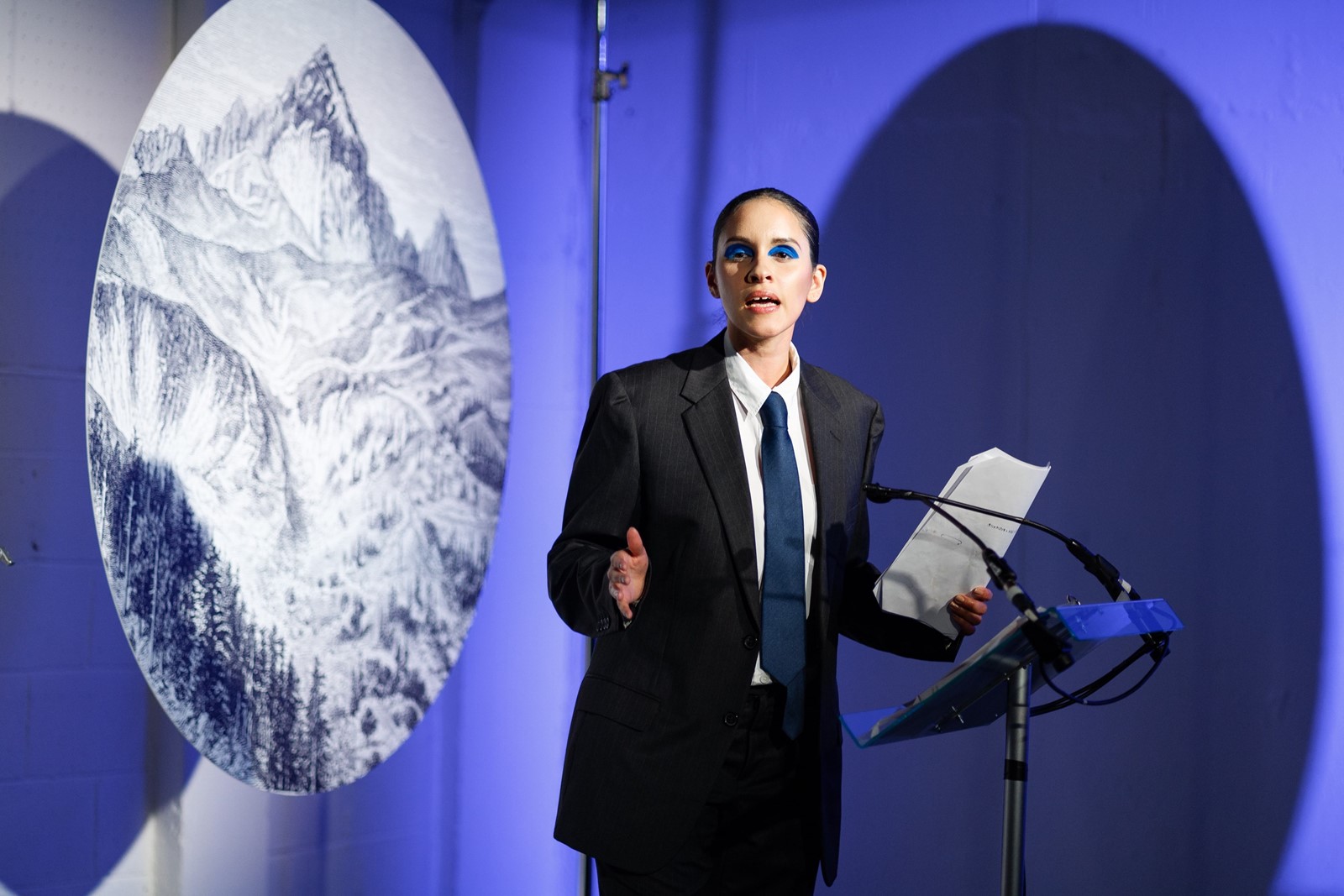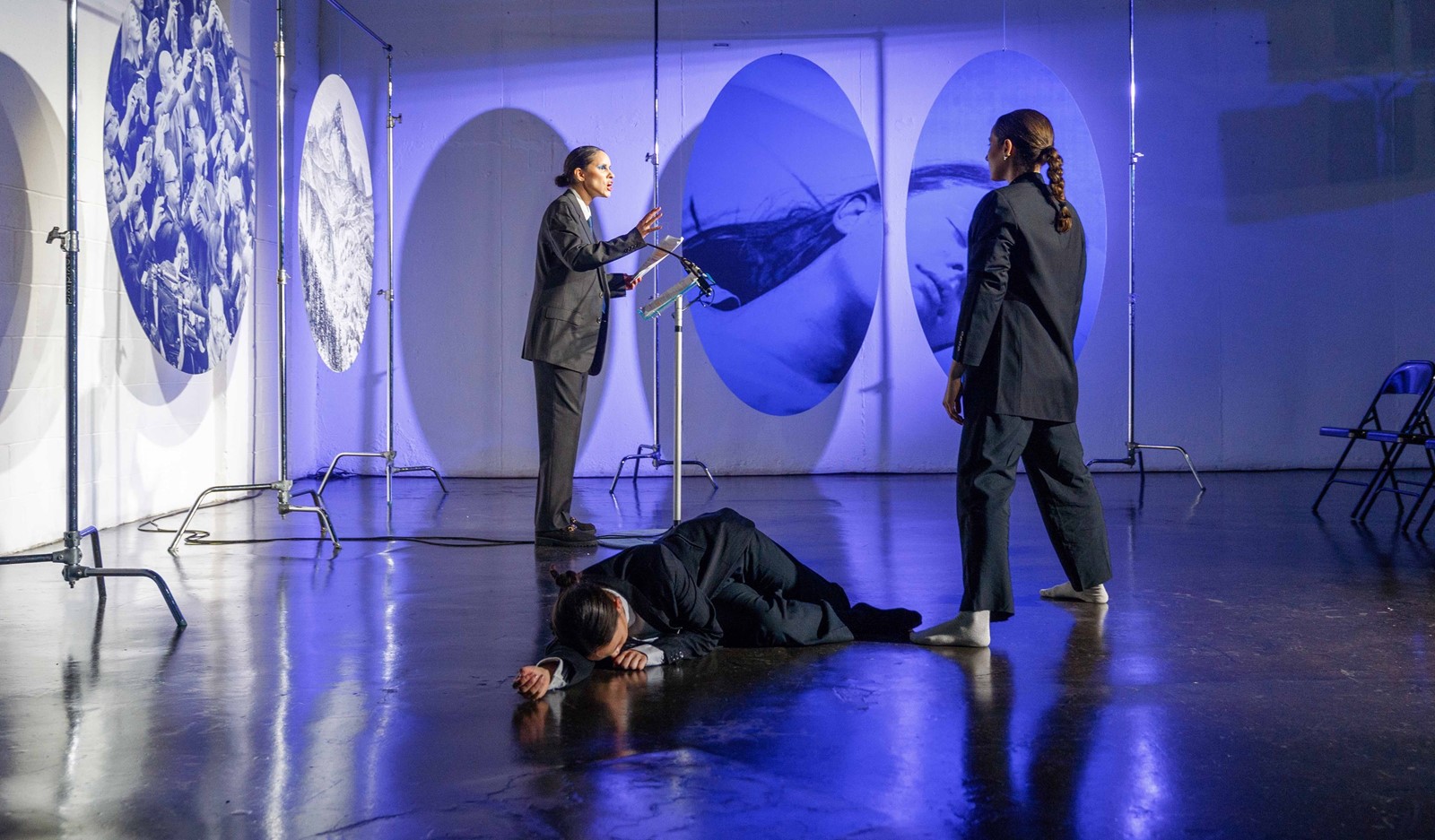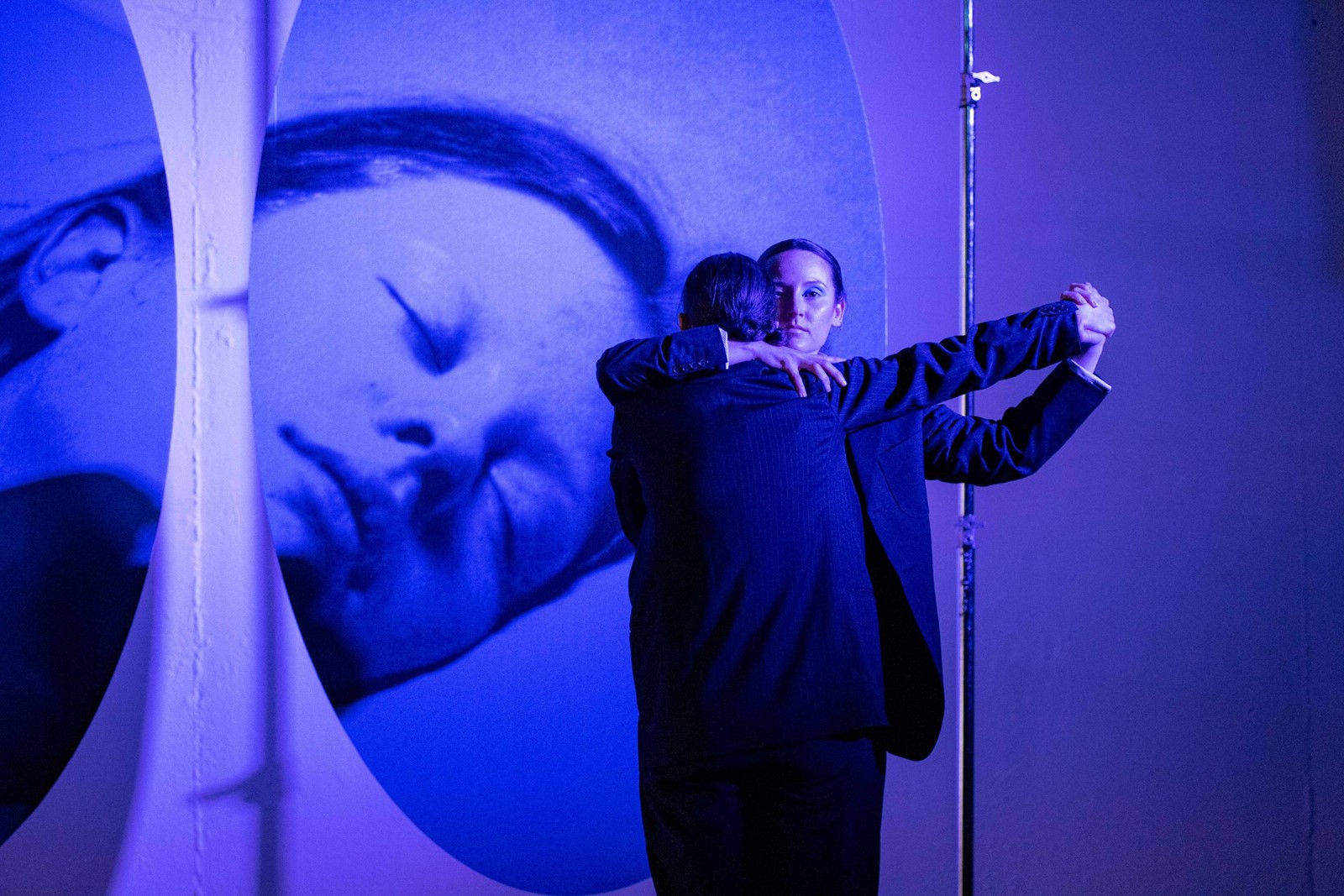Art In Relation: how can art allow human beings to live together sustainably and in relation to one another? In this series, Chinese-Canadian curator and writer Kate Wong speaks to artists working across performance and film about the role of storytelling in their practices and about creating work that allows us to come together in a world that tries its very best to keep us apart.
It’s been nearly a month since Harriet Middleton Baker’s show, The Conference, debuted at The Robert’s Institute of Art in London. Commissioned in April 2020 as part of a development programme for artists, Baker’s performance presented a dystopian world in which sleep – our last bastion against the extractive forces of capitalism – is seen as an opportunity for progress and development. Coincidentally (or not), our conversation about the performance had to be postponed due to work, illness and even a broken wrist!
As its title infers, the performance takes the shape of a conference where a powerful world leader delivers a sinister keynote speech; a vision of the future. Acknowledging the important lesson of slowness that can be learned from nature, and the state of “ceaseless acceleration” that society finds itself in, the speaker appears at first to be making a case for slowing down. However, following this introduction, things take a dramatic turn. The speaker presents to the audience ‘The Rest Revolution’, a horrific near future where sleep has been harnessed for its potential to increase both productivity and profit.
The Conference is an exercise in thinking through neoliberal ideology and its implications on rest, and on our spiritual and emotional lives.

Kate Wong: Your performance, The Conference, presents a proposal for “The Rest Revolution”, a world in which not only sleep but even dreams are capitalised upon and captured as “fuel for the future”. How did this performance come about, and can you tell me more about some of the themes you are exploring?
Harriet Middleton Baker: The performance came about through ongoing research into the performance and choreography of power, particularly in the upper echelons of governance – be that political or corporate. I’m interested in the way certain types of performance are utilised as demonstrations of power, and how those performances are received by our bodies.
In The Conference, I chose to explore the format of a global summit where these two forces – the political and the corporate – collide. I wanted to get closer to that power, to understand how it works, how it feels and how it exercises itself. Proximity feels important to this kind of power, it relies on the elitism of distance. It hides, albeit rather publicly, in the Swiss mountains.
“The Rest Revolution”, the subject of the speech offered by the keynote speaker for The Conference, represents a kind of horror. It is the horror of being offered a “solution” that is in fact a curse; the way technology, as a capitalist enterprise, so often does. The promise of ‘efficiency’ may seem to make things easier, but in fact usually comes with the caveat of data extraction and unrelenting, exhausting speed.
Personally, at this moment I am exhausted. While processing the collective grief of the last few years, I am trying to work enough to afford London rents, trying to maintain an artistic practice, and trying to keep myself alive in all the myriad of ways we must do – the endless maintenance of living. What scares me most about this state of being is the way this exhaustion – exacerbating the body’s vulnerability, softness and need for care – can instead be seen as an opportunity. This is a great horror, and a key part of the work.
Why I am drawn to explore and represent horror is something I am still figuring out. Maybe I am just angry and this is my way of coping, or perhaps I have a perversity that needs some more exploring. I used humour in the piece as a kind of cushioning; comedy can open up some space in order to get a little bit closer to horror without feeling the full strength of its bite.
“I want to understand why and how an economic system hell-bent on extracting every last drop of energy on this earth – whether that is oil, gas, love or time – could concurrently be so successful, so shiny, so alluring” – Harriet Middleton Baker
KW: What is it about the framework of a conference, and even more specifically, the format of a speech that compels you?
HMB: A conference setting is about density in space. It is designed to bring bodies closer together with a commonish(ish) purpose, to encourage exchange, and to promote communication and the sharing of knowledge. However, it can also be about elitism and exclusion: who is represented in what space and why is very important. The conference that I referenced most prominently in the work was The World Economic Forum at Davos, where global state leaders mingle with corporate leaders in an effort to ‘save the world’.
Within the confines of this space there are yet more spheres, hierarchies and shapes of power. Leaders from the global north and global south, CEOs of tech corporations and heads of transnational organisations, are all jostling to increase their sphere of influence. There’s something about that ability to create, to maintain and to grow power that interests me. What is leadership and why do certain people desire it? What kinds of behaviours are enacted to attain this kind of status? Could you call that choreography?
The keynote speech is a great example of power and performance working together. The speech itself is performative, regardless of its content. The speech – with all of its theatrical notes and careful vocal dynamics – activates a sense of validity in the speaker. To stand at the centre of a crowd, to draw attention and to linguistically influence, is to command a kind of power.
During The Conference, two dancers – ostensibly delegates or attendees at the imaginary gathering – performed how it might feel to listen to that kind of persuasive speech, using their bodies to attend to the sensual registers that power can inflict on another’s body.

KW: You collaborated with an actor, two dancers and a cellist. How important were your collaborators in the development and do you consider your practice a collaborative one?
HMB: The process of collaboration is deeply important to me. For this piece I worked with actor and singer Siân Roseanna, dancer-choreographers Madison Capel-Bird and Lydia Buckler, and cellist Gamaliel Rendle Traynor. Because I have a pretty eclectic background (dance, architecture, TV), collaboration is my natural way of working. I think most art practices are more collaborative than current authorship models often permit, and it’s something I think about a lot. Art is rarely an entirely solo activity, though it is usually credited as such.
I was also conscious of taking a directorial role in this work, which also then creates a set of relations and power dynamics within the group of collaborators to navigate and explore. My main priority when collaborating in this way is to create an environment where everyone feels supported and cared for, while being able to enjoy the process of being and working together. We ask a lot of each other during the process and, in return, make sure we respect each other’s ways of moving. This relationship of mutual care was so important to me, as I felt the support of the performers as much as I supported them in return.
KW: As you mentioned, you have dance training yourself. What was the choreographic process like for The Conference? Were there guiding principles for the movement? To me, it felt like the dancers were entangled in a kind of mutual dependency.
HMB: The two dancer-choreographers I worked with, Madison Capel-Bird and Lydia Buckler, have an ongoing dance duo practice that they brought beautifully to the work. Because they know each other – and each other’s bodies – so intimately, and they choreograph in such a way that highlights this kind of mutual dependency. We worked together through a series of exchanges. I would present a dramaturgical framework and the language of the speech, and they would respond with movement and gesture.
Once we got into the rehearsal phase, the choreography responded more directly to Siân’s delivery: how she would enunciate certain phrases, how her tone would switch from friendly and folksy, to commanding and direct. Similarly, the cellist, Gamaliel, worked with a series of sounds and phrases we developed together that responded to both the speech and the choreography, playing with the theatricality of the genre; quivery minor strokes and plucky staccato giving the audience a wink and a nudge as to who the villain might be in this vignette.
“While processing the collective grief of the last few years, I am trying to work enough to afford London rents, trying to maintain an artistic practice, and trying to keep myself alive in all the myriad of ways we must do – the endless maintenance of living“ – Harriet Middleton Baker
KW: I loved the set you created. Can you tell me more about the steel frames and the images that hung, almost as banners, from them?
HMB: The set included printed banners suspended from chrome photographic backdrop frames. I wanted to suggest rather than illustrate a conference setting, paying homage to the ad-hoc am-dram and small-scale theatre. It’s also an attempt at Brechtian staging, like saying “this is a backdrop on a theatrical backdrop”, letting the audience in on the joke.
The images were of a crowd of reporters clamouring for a glimpse of some global leader at Davos, an 18th-century etching of Matterhorn (a mountain peak in Switzerland) and a film still from a recent sci-fi movie of a girl sleeping.
KW: Your practice looks broadly at structures and systems of power and the aesthetics of techno-capitalism. Where does this fascination with late-stage capitalism come from?
HMB: My fascination comes from wanting to know, with greater clarity, what forces my body is up against. I want to know why I am so tired all the time. I want to understand why and how an economic system hell-bent on extracting every last drop of energy on this earth – whether that is oil, gas, love or time – could concurrently be so successful, so shiny, so alluring. Power exploits the ambivalences of desire, and through my research, I want to get closer to that ambivalence and feel its texture. Maybe with that knowledge, I would feel better equipped to resist and dream in another direction.

KW: Your performance felt to me at once to be a Davos-like conference, but also a kind of beautiful and poetic dream. You’ve mentioned sensuality already in relation to thinking through and choreographing the impacts of power. Could you speak about dreams and how they relate to and are distinct from aspirations?
HMB: I wonder if my current aspiration is to daydream away from the form of aspirations … maybe that’s why I’m feeling topsy-turvy. But yes, I suppose the difference for me is the directionality of aspiration versus the looseness and meandering quality of dreams. I think daydreams can resist the formal equation of distance – speed and time, all factors socially constrained – while allowing you to travel away from the confines of our fleshy realities.
Dreams are obviously an enormous subject, and in the context of this work, I would say it could also be worth exploring the difference between daydreams and night-dreams. I wonder how you might compare these three forms of imagination: the aspiration, the daydream and the night-dream.
KW: As an artist living and working in London, how do you personally find time for rest? And do you think this city holds space for dreaming?
HMB: Not enough. Being an artist can mean participating in a weird and often perverse economy, on top of the larger, weirder frameworks of the capitalist economy. Sometimes I dream about universal basic income – with all its flaws – sometimes I dream about disappearing into the woods, sometimes I dream about a world without work and infinite abundance. Today I’m just dreaming about how I’ll make it through next week with a heavy workload and a broken wrist.
KW: I am sending you and your wrist both lots of healing energy! And finally, how do you think we as human beings can live together truly in relation?
HMB: First things first, everyone needs some time off to rest, relax and dream a little. Then we take it from there.
